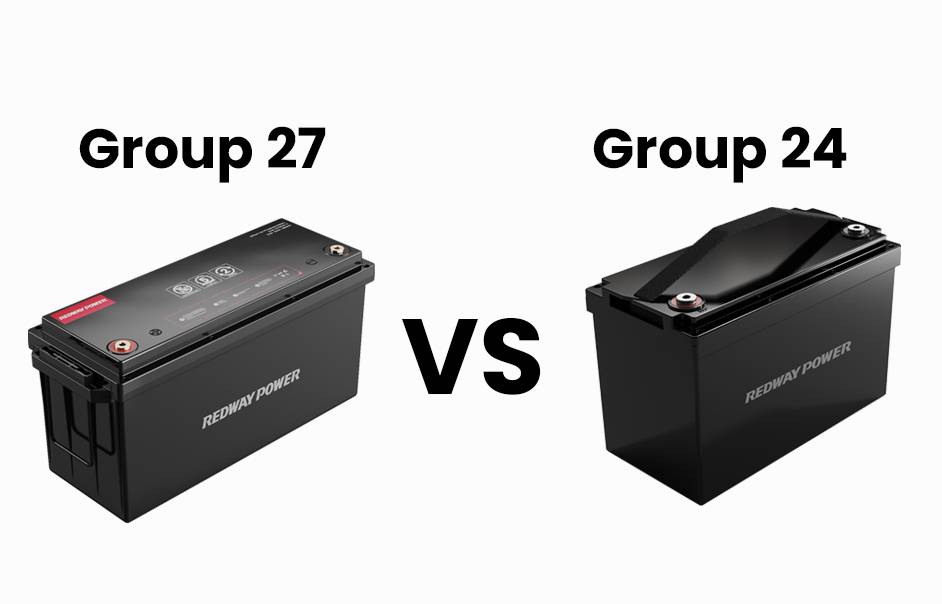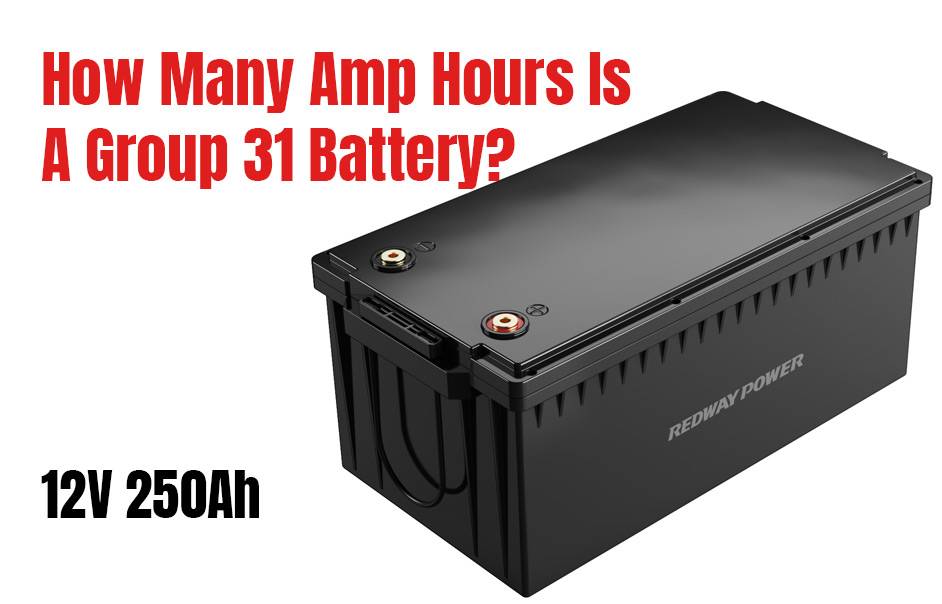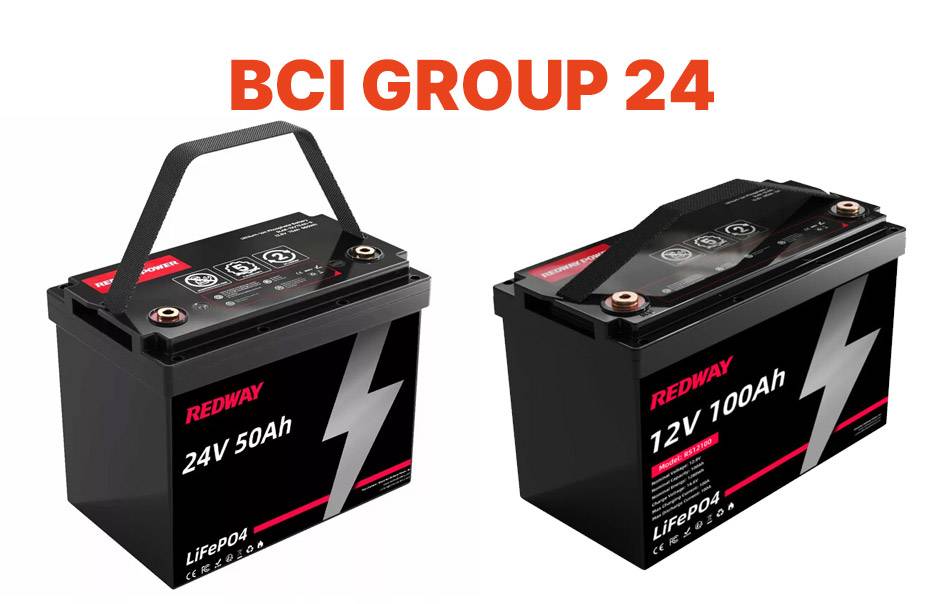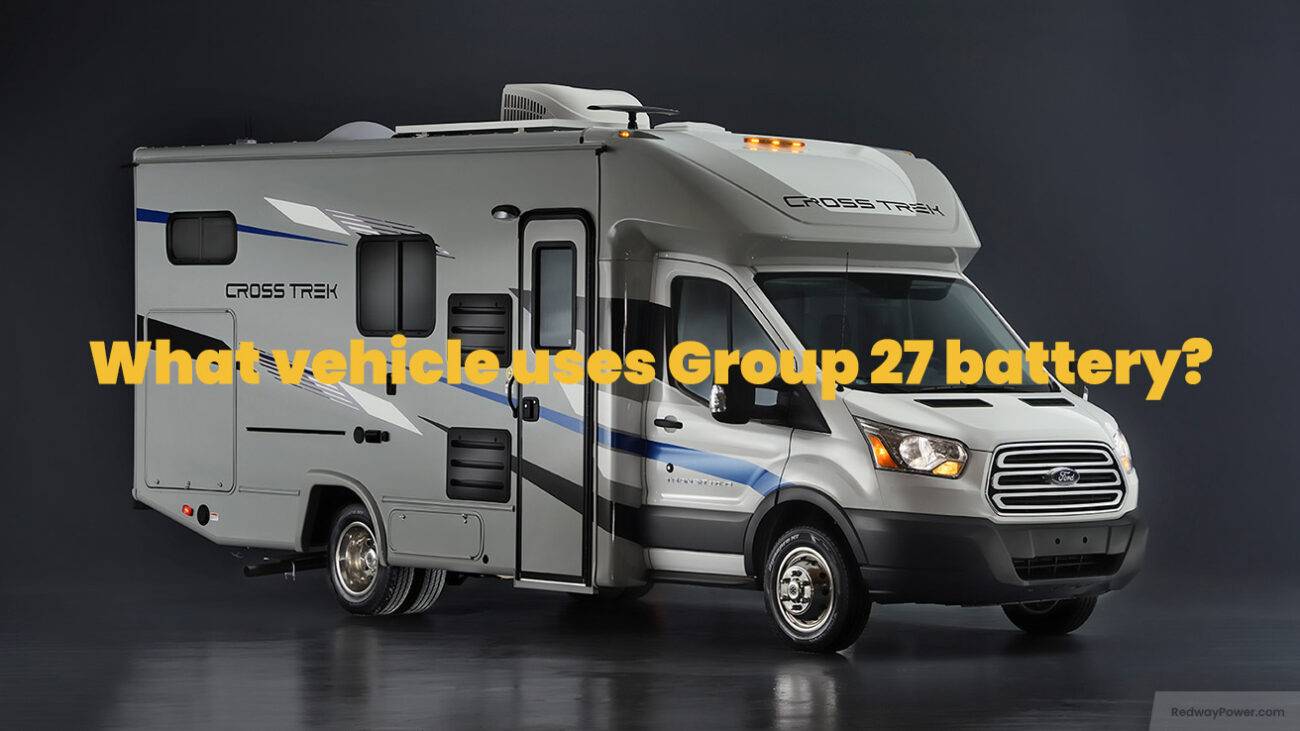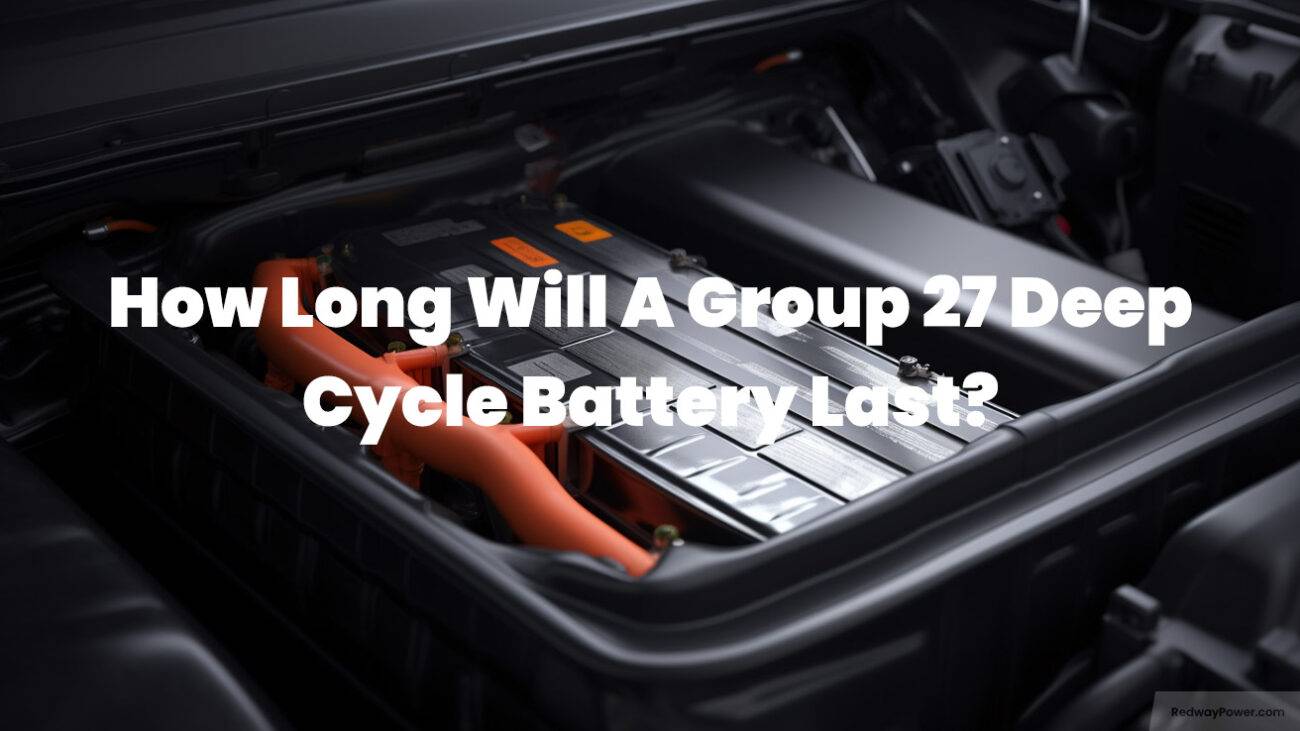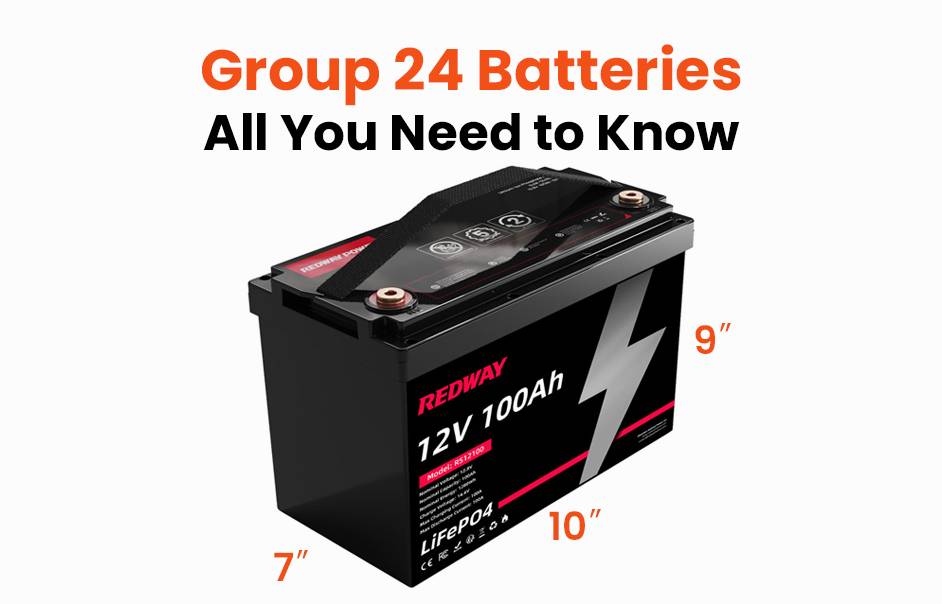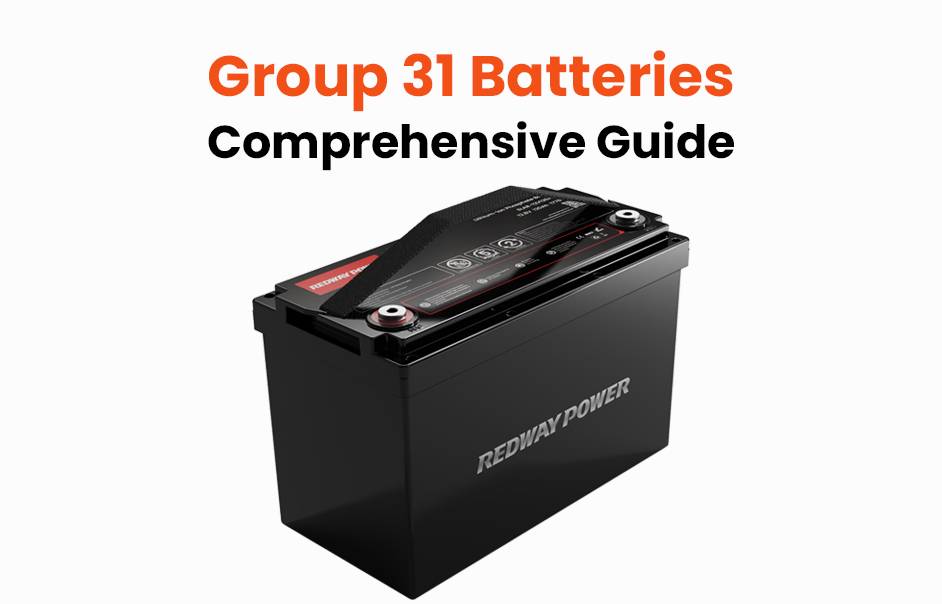Group 27 batteries typically feature higher cold-cranking amps and reserve capacity than Group 24 batteries, making them suitable for larger vehicles like trucks and SUVs. Size, capacity, terminal types, and price are key factors to consider when choosing between them. Also check: BCI Battery Group Size Chart (Group 24, 27, 31, etc)
Understanding Battery Groups
Understanding battery groups is crucial for selecting the right battery size and specifications. Standardized by the Battery Council International, group numbers denote battery dimensions and compatibility. For example, Group 24F fits Honda, Toyota, Nissan, and Acura vehicles. Each group corresponds to distinct sizes and electrical specifications, aiding in meeting specific application requirements.
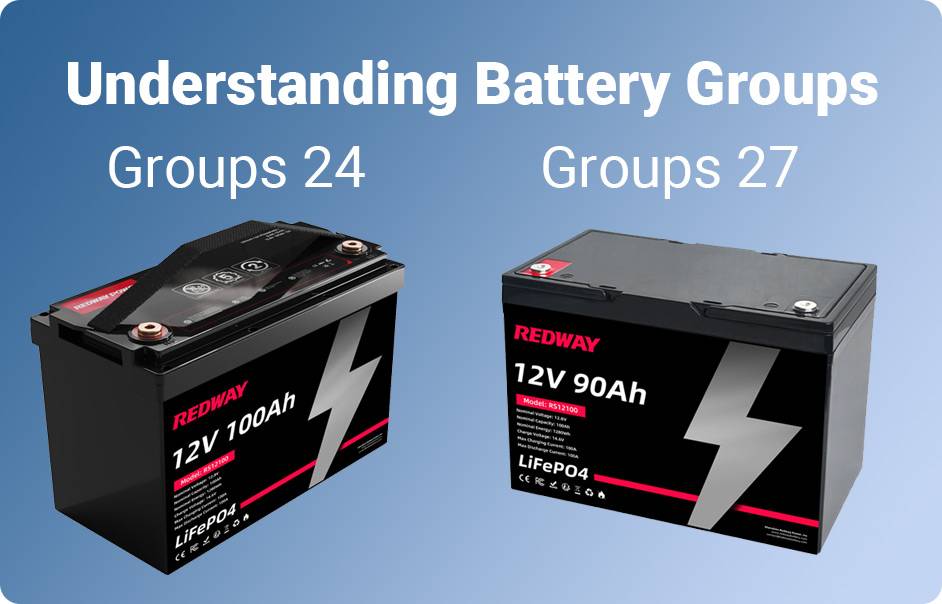
Key Insights:
- Definition of Battery Groups:
- Classifications indicating the size and specifications of batteries.
- Standardized codes facilitating compatibility with diverse devices and equipment.
- Purpose of Battery Groups:
- Provide details about battery case dimensions, including length, width, and height.
- Specify voltage and capacity information for easy identification.
- Example of Group 27 Batteries:
- Dimensions approximately 12 inches in length, 6.75 inches in width, and around 9 inches in height.
- Varied electrical performance characteristics, including voltage output and storage capacity.
- Variations in Group Numbers:
- Different group numbers (e.g., Group 24 or Group 27) correspond to distinct sizes and electrical specifications.
- Each group is designed to meet specific application requirements.
Understanding battery groups sets the foundation for exploring the nuances of each group, beginning with a closer look at Group 27 batteries.
What are Group 27 Batteries?
Group 27 batteries, standardized by the Battery Council International, are renowned for their larger size and enhanced capacity. Typically measuring around 12 x 6.75 x 9 inches, they offer higher cold-cranking amps (CCA) and reserve capacity (RC), making them ideal for larger vehicles like trucks and SUVs. With CCA ranging from 600-1000 and RC from 140-220 minutes, they ensure reliable starting power and extended usage.
Group 27 batteries stand out as a popular choice. Renowned for their larger size and enhanced capacity, these batteries find extensive use in various applications. Generally, group 27 batteries feature physical dimensions of 12.0625 x 6.8125 x 8.875 inches (306 x 173 x 225 mm), and as such, they are slightly smaller than group 31 batteries.
Most group 27 batteries are Sealed Lead Acid (SLA) Absorbent Glass Mat (AGM) deep cycle batteries, and very popular. But Redway has great replacements like 12V 90Ah and 12V 105Ah lifepo4 battery. Click to check.
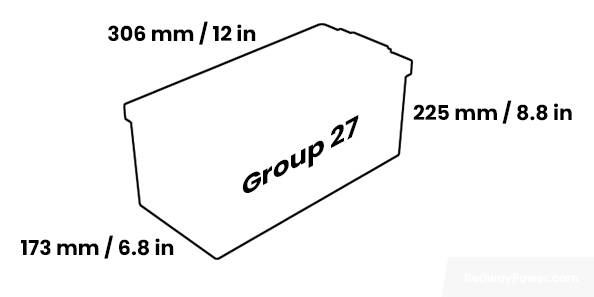
Key Points:
-
- Weight Range: Group 27 batteries typically weigh between 54 and 70 pounds (24.5 – 32 kg), depending on the internal construction, such as flat plates or spiral wound plates.
- Reserve Capacity (RC): The Reserve Capacity of Group 27 batteries ranges from 140 to 220 minutes, providing ample reserve power for extended usage without frequent recharging.
- Cold Cranking Amps (CCA): Group 27 batteries typically have a Cold Cranking Amps (CCA) range of 600-1000, ensuring reliable starting power even in cold weather conditions.
- 20h Capacity Range: On average, Group 27 batteries feature a 20h capacity in the 66-110 Ah range, providing sufficient power for various applications.
Group 27 batteries offer a compelling combination of high capacity and dependable performance for diverse applications. While their larger size demands consideration of available space, their extended running time and resilience in tough conditions make them a valuable choice. Tailor your decision based on specific needs when selecting from different battery groups!
What are Group 31 batteries?
Group 31 batteries, standardized by the Battery Council International (BCI), measure approximately 13 x 6.8 x 9.44 inches. They offer higher cold-cranking amps and reserve capacity, ideal for heavy-duty applications like commercial trucks and marine vessels. Compared to Group 27 batteries, Group 31 batteries provide superior performance in demanding environments.
Group 31 batteries stand out for their durability and longevity, making them a preferred choice in industries where downtime is costly. Their enhanced performance characteristics make them well-suited for deep cycle applications, ensuring consistent power delivery even in challenging conditions. With their versatility and reliability, Group 31 batteries continue to play a vital role in powering essential machinery and vehicles across various sectors, contributing to increased efficiency and productivity in diverse operations.
Group 27 vs Group 31 batteries in physical dimension
When comparing Group 27 and Group 31 batteries, Group 27 is slightly smaller, measuring 12.0625 x 6.8125 x 8.875 inches. Group 31 batteries, typically 13 x 6.75 x 9.5 inches, offer higher capacity. Group 27 batteries are popular as SLA AGM deep cycle batteries
Despite their smaller size, Group 27 batteries are widely favored for their versatility, particularly in applications requiring Sealed Lead Acid (SLA) Absorbent Glass Mat (AGM) deep cycle batteries. Their compact dimensions make them suitable for various installations where space may be limited.
On the other hand, Group 31 batteries, though larger, offer advantages in terms of capacity and power. With their increased size, they can accommodate higher capacity, making them ideal for heavy-duty applications where a reliable power source is essential. These batteries are often chosen for commercial trucks, marine vessels, and industrial equipment, where their robust construction and superior performance characteristics are highly valued. Ultimately, the choice between Group 27 and Group 31 batteries depends on specific application requirements, balancing size constraints with desired performance metrics.
Key Considerations for Selecting a Group 27 Battery Replacement
When searching for a suitable replacement for a Group 27 battery, consider charging compatibility, performance matching, capacity, current ratings, and size compatibility. Ensure the new battery aligns with your system’s requirements for optimal performance and longevity. Detailed assessment of power needs, size limitations, and compatibility is crucial for seamless installation and operation.
- Charging Compatibility: It is crucial to ensure that the new battery can be properly charged using the available chargers. Proper charging is essential for maintaining performance, longevity, and overall functionality.
- Performance Matching: The new battery should be at least equal to or better in performance compared to the old battery. This ensures that it can meet the power requirements and function correctly in the application.
- Capacity and Current Ratings: Consider the capacity, CCA/MCA currents, and RC values of the replacement battery. These specifications are critical for ensuring that the new battery meets or exceeds the performance of the old one.
- Size Compatibility: Check the actual size of the old battery and the battery compartment when selecting a replacement. Ensuring compatibility and proper fitment is essential for seamless installation and operation.
- Detailed Assessment: Assess various detailed factors, including power requirements, size limitations, pricing, and compatibility with existing systems. This comprehensive evaluation ensures that the chosen replacement battery aligns perfectly with your specific needs.
In summary, careful consideration of charging compatibility, performance matching, capacity and current ratings, size compatibility, and other detailed factors is essential when selecting a proper replacement for a Group 27 battery.
What are Group 24 Batteries?
Group 24 batteries, part of the BCI classification, offer reliable performance and versatility. With dimensions of approximately 10.25 x 6.8125 x 8.875 inches, they are commonly used in UPS systems, vehicles, and industrial settings. Despite their compact size, Group 24 batteries provide substantial power output and capacity, making them popular for diverse needs.
Group 24 batteries have earned their popularity by delivering dependable performance and versatility across diverse applications. However, there are also additional subgroups available. Group 24 batteries are a regular type.
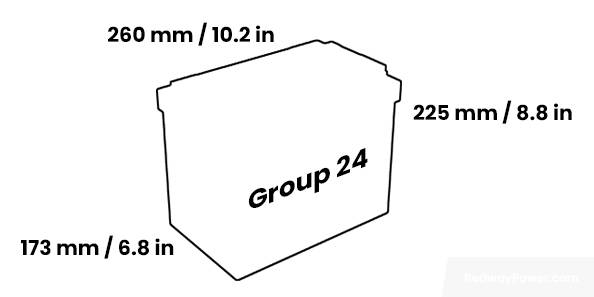
BCI Group 24 batteries are versatile batteries widely used in various applications such as large UPS systems, medical and security systems, wheelchairs, vehicles, and industrial settings. They are seldom used to start engines; more frequently, they are employed in applications where a deep cycle standby or float is needed. But Redway has great replacements like 12V 50Ah and 12V 75Ah lifepo4 battery. Click to check.
While these batteries share similarities, it’s important to highlight that the BCI Group 24F is slightly longer and wider than other groups. Even with variations in height, battery compartments typically have some spare height. If they can accommodate a Group 24 battery with an 8 7/8 inch height, they can often accommodate batteries from Group 24T as well. Group 24T has a height of 9 3/4 inches, which is 7/8 inch (0.875 inch or approximately 22 mm) taller than the ‘standard’ Group 24 battery.
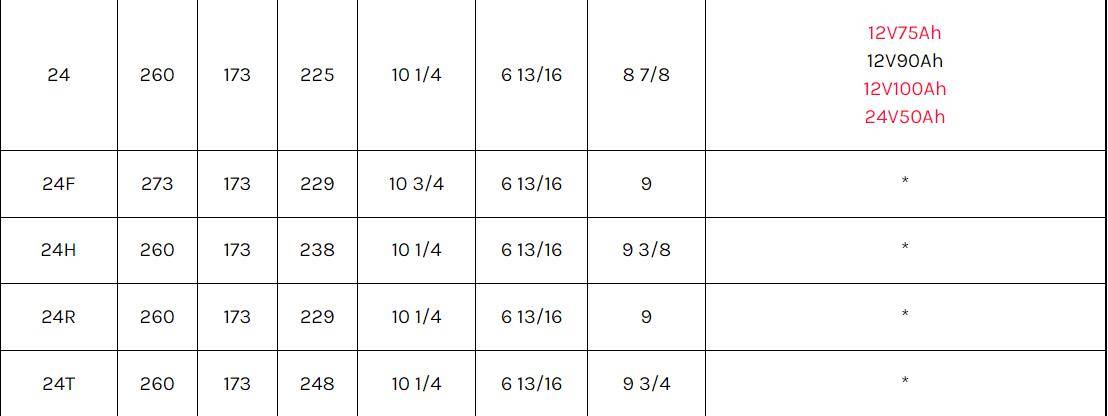
Key Features:
- Compact Size Advantage:
- Group 24 batteries, smaller than their Group 27 counterparts, are ideal for installations with limited space.
- Despite their compact design, these batteries offer substantial power output and capacity.
- Versatility Across Applications:
- Group 24 batteries exhibit compatibility with a broad spectrum of vehicles and equipment.
- Whether for cars, boats, RVs, or solar power systems, Group 24 batteries are a versatile choice.
- Low Maintenance Requirements:
- Group 24 batteries typically demand minimal upkeep, with some models incorporating advanced technologies to reduce self-discharge rates.
- These features contribute to an extended battery lifespan.
- Warranty Assurance:
- Many manufacturers provide warranties on Group 24 batteries, assuring consumers of the product’s quality and reliability.
- This warranty coverage enhances consumer confidence in their investment.
Check BCI Battery Group Size Chart (Group 24, 27, 31, etc) to know more.
Key Differences Between Group 27 and 24 Batteries
Group 27 batteries typically offer higher cold-cranking amps and reserve capacity, ideal for larger vehicles like trucks and SUVs. Group 24 batteries are slightly smaller and may have lower capacity. Factors to consider include dimensions, capacity, terminal types, and price dynamics, ensuring the right choice based on vehicle needs and budget.
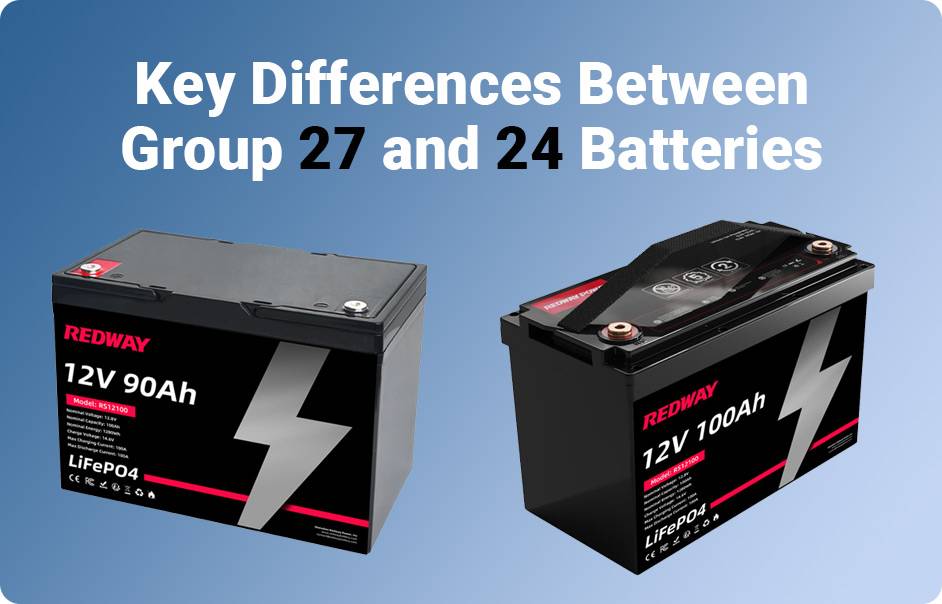
Key Differences:
- Dimensions Matter:
- Group 27 batteries are approximately 12 inches in length, slightly longer than Group 24 batteries at around 10 inches.
- In limited under-the-hood space, these inches can make a significant difference.
- Capacity Contrast:
- Group 27 batteries generally boast higher amp-hour ratings than Group 24 batteries.
- This translates to a capacity advantage, allowing Group 27 batteries to hold more charge and provide longer-lasting power.
- Terminal Types Vary:
- While both groups usually feature top-post terminals, some manufacturers may offer side-post terminals for specific applications exclusively in either Group 27 or Group 24 batteries.
- Price Dynamics:
- Price disparities exist between the two groups due to differences in manufacturing processes and materials.
- Prices may fluctuate based on brand and quality considerations.
Choosing between Group 27 and Group 24 batteries hinges on specific vehicle needs. Whether it’s size constraints, capacity requirements, terminal preferences, or budget considerations, consulting your owner’s manual or seeking professional advice is essential for informed battery replacement or upgrade decisions!
Group 27 vs Group 24 marine batteries
Choosing between Group 27 and Group 24 marine batteries depends on factors like available space, trip duration, power demands, and budget. Group 27 batteries offer larger size and higher capacity, suited for boats with ample space and longer runtime needs. Group 24 batteries are ideal for vessels with limited space and lighter electrical demands, balancing reliability and performance on the water.
Moreover, the decision between Group 27 and Group 24 batteries ultimately hinges on individual boating needs and preferences. Group 27 batteries typically feature higher Amp-hour (Ah) ratings, indicating superior energy storage capacity and extended runtime compared to Group 24 batteries. However, Group 24 batteries may be preferred for vessels with lighter electrical demands and more frequent recharging opportunities. By carefully considering factors such as available space on the boat, trip duration, electrical demands of onboard devices, and budget constraints, boaters can make informed decisions to ensure reliable power supply and optimal performance during their marine adventures.
What are the important factors to consider before purchasing a new Group 27 battery?
Before buying a Group 27 battery, consider essential factors for optimal selection. Check compartment dimensions, review manufacturer labeling, note weight variations (54-70 lbs), and understand battery types like SLA, AGM, and lithium. This ensures compatibility and maximizes performance, avoiding issues and enhancing battery longevity.
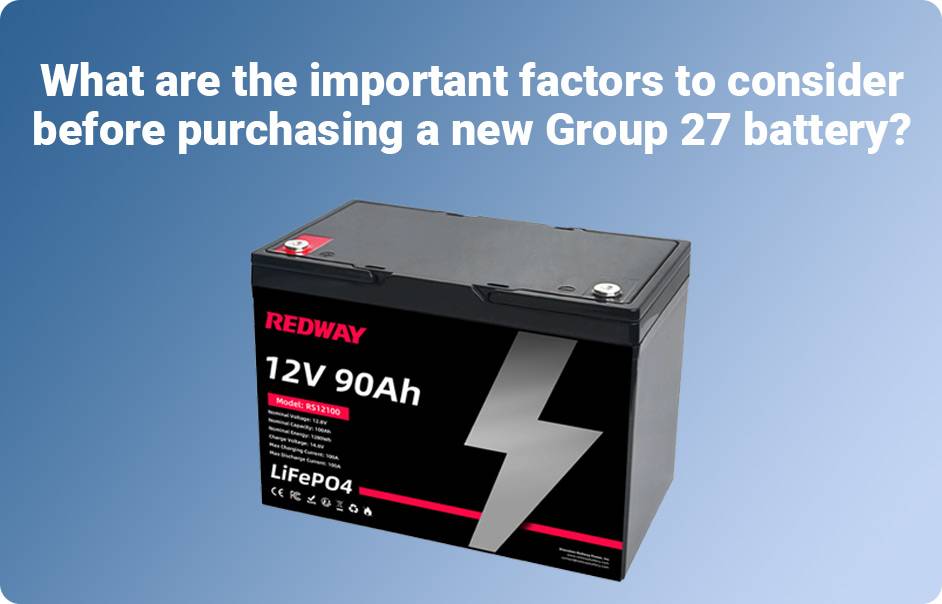
- Check Battery Compartment Dimensions: It’s crucial to verify the actual dimensions of your battery compartment to ensure compatibility and avoid fitment issues.
- Manufacturer Labeling: Manufacturers typically provide both actual dimensions and BCI Group Size when labeling batteries, aiding buyers in making informed decisions.
- Weight Variations: Group 27 battery weights vary based on internal construction, such as flat plates or spiral wound plates, ranging between 54 and 70 pounds (24.5 – 32 kg).
- Battery Types: Common types of Group 27 batteries include Sealed Lead Acid (SLA) Absorbent Glass Mat (AGM), dual-purpose AGM, and lithium batteries. Understanding the differences between these types can help you choose the right one for your application.
Considering these factors ensures that you select the most suitable Group 27 battery for your specific requirements, avoiding compatibility issues and maximizing performance.
Factors to Consider When Choosing Between Group 27 and 24 Batteries
Consider crucial factors when choosing between Group 27 and Group 24 batteries. Assess power needs—Group 27 offers higher capacity. Check size constraints and compatibility. Group 24 batteries may be more budget-friendly. Ensure compatibility with existing charging systems. Evaluate power needs, size, pricing, and compatibility for an informed decision.
Key Factors to Consider:
- Assess Power Needs:
- Determine if you need high capacity and longer runtime, leaning towards a Group 27 battery.
- Size Matters:
- Group 27 batteries are larger and heavier, potentially posing fitment challenges. Check dimensions to ensure compatibility.
- Price Considerations:
- Group 24 batteries are generally more budget-friendly due to their smaller size and lower capacity.
- Compatibility Check:
- Ensure the chosen battery group aligns with your existing charging system or device requirements.
Carefully evaluate power needs, size constraints, pricing, and compatibility before deciding between Group 27 and Group 24 batteries. This ensures a well-informed choice that aligns with your specific requirements!
Applications for Group 27 and 24 Batteries
Group 27 batteries power large vehicles like trucks and RVs, offering high capacity for extended trips. In contrast, Group 24 batteries suit smaller vehicles like cars and motorcycles, providing ample power for everyday use. Both types find applications in off-grid systems, with Group 24 batteries being compact and versatile, fitting into tight spaces effortlessly.
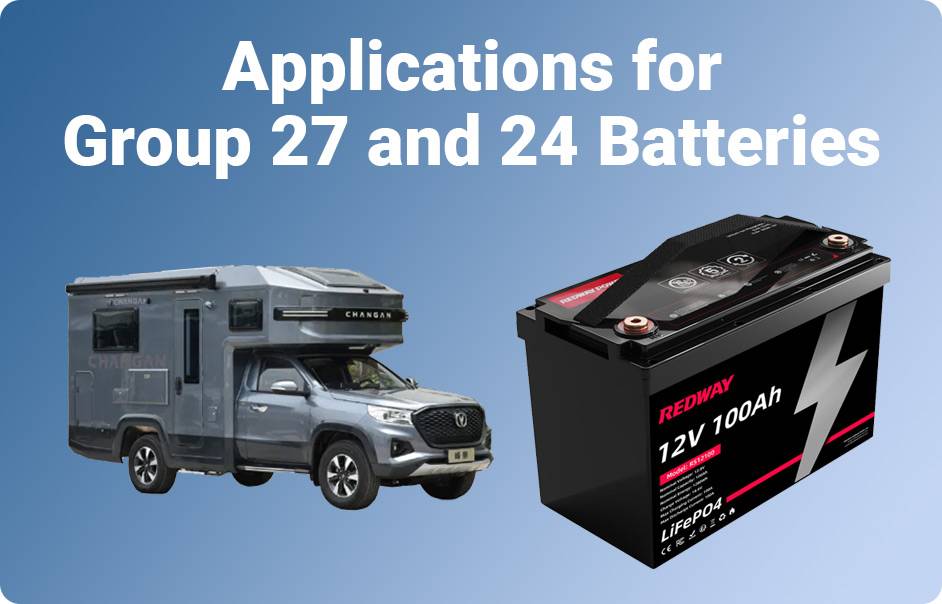
Applications of Group 27 Batteries:
- Large Vehicles:
- Trucks, RVs, and boats commonly utilize Group 27 batteries.
- Higher Capacity:
- Ideal for extended trips, these batteries power multiple accessories simultaneously.
Applications of Group 24 Batteries: 3. Smaller Vehicles:
- Cars, motorcycles, and small boats often use Group 24 batteries.
- Compact and Versatile:
- Fitting into tight spaces, they provide ample power for everyday use and shorter trips.
Common Off-Grid Applications: 5. Off-Grid Systems:
- Both groups find applications in solar power systems or backup power supplies for off-grid setups.
Conclusion: Consider capacity needs, available space, and intended use duration when choosing between Group 27 and Group 24 batteries. Understanding their applications ensures you make an informed decision tailored to your specific requirements, providing reliable power wherever you go!
FAQs
What is the difference between a 24 and 27 series battery? The main difference between a 24 series and a 27 series battery is their physical size and capacity. Generally, a 27 series battery is larger and has a higher capacity compared to a 24 series battery.
Can I mix Group 24 and Group 27 batteries? It’s not recommended to mix different group sizes of batteries, such as Group 24 and Group 27, in the same battery bank. Mixing batteries with different capacities and characteristics can lead to uneven charging and discharging, potentially causing damage to the batteries and reducing their overall lifespan.
What does Group 27 battery mean? A Group 27 battery refers to a specific size and type of lead-acid battery commonly used in automotive, marine, and RV applications. It typically has dimensions and capacity specifications that fall within the Group 27 battery size category.
How many amp hours is a group 24 battery? The amp-hour (Ah) rating of a Group 24 battery can vary depending on the specific battery model and manufacturer. Generally, Group 24 batteries have amp-hour ratings ranging from around 70 Ah to 100 Ah or more, depending on whether they are standard flooded lead-acid, AGM (absorbent glass mat), or gel batteries.
Is a group 27 battery bigger than a group 24? Yes, typically, a Group 27 battery is larger than a Group 24 battery in terms of physical size and capacity. Group 27 batteries are designed to have higher capacity and are physically larger to accommodate additional cells.
How long will a group 27 deep cycle battery last? The lifespan of a Group 27 deep cycle battery depends on factors such as usage patterns, charging practices, maintenance, and environmental conditions. Generally, well-maintained deep cycle batteries can last anywhere from 3 to 10 years or more.
What vehicles use a group 27 battery? Group 27 batteries are commonly used in various vehicles and applications, including:
- Recreational vehicles (RVs)
- Marine vessels
- Golf carts
- Utility vehicles
- Some automotive applications
How many amps is a group 27 battery?
The amp rating of a Group 27 battery varies depending on the specific battery model and manufacturer. Generally, Group 27 batteries can have amp ratings ranging from around 500 to 1000 amps or more for starting applications, and lower amp ratings for deep cycle or marine applications.
What does Group 24 battery fit?
Group 24 batteries are designed to fit a wide range of vehicles and applications, including:
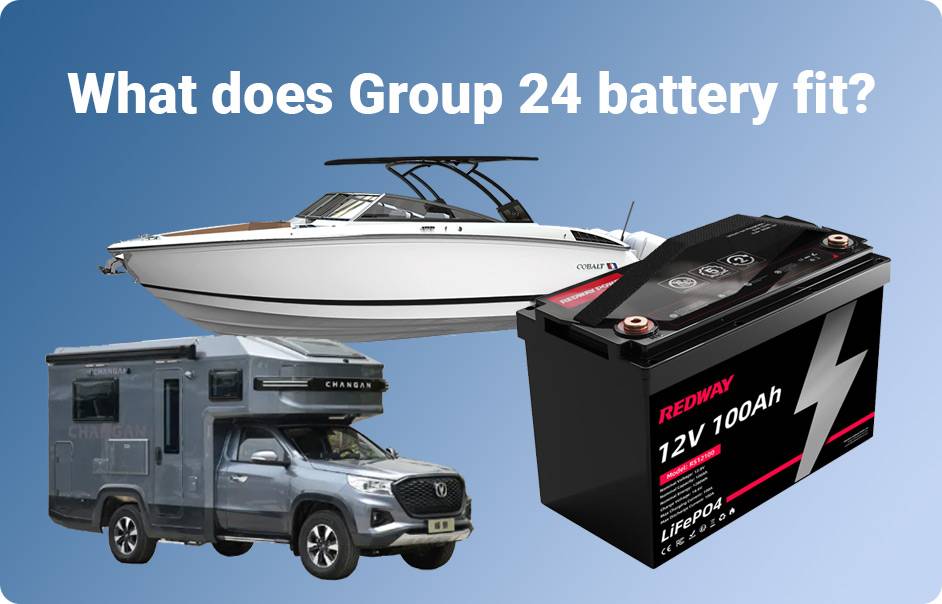
- Automotive vehicles
- Recreational vehicles (RVs)
- Marine vessels, Electric Boat
- Golf carts
- Lawn and garden equipment
How long does it take to charge a group 27 battery?
The time it takes to charge a Group 27 battery depends on factors such as the charging current, the state of charge of the battery, and the type of charger used. Typically, charging a Group 27 battery from a fully discharged state can take several hours to overnight, depending on the charger’s capacity and the battery’s capacity.
How many amp hours is a 27 AGM battery?
The amp-hour (Ah) rating of a Group 27 AGM battery can vary depending on the specific battery model and manufacturer. Generally, Group 27 AGM batteries have amp-hour ratings ranging from around 80 Ah to 120 Ah or more, depending on their intended application and design.
What is the difference between 27 and 27F battery?
The designation “27F” typically refers to a specific type or variant of Group 27 battery, often used in automotive applications. The main difference between a Group 27 and a Group 27F battery may be specific design characteristics or features tailored for particular vehicle models or requirements, such as different terminal configurations or performance specifications.
How long does it take for a 10 Amps battery charger to charge a lead-acid battery at 80% DoD and 50% DoD?
To determine the charging time for a lead-acid battery using a 10 Amps battery charger, we can consider two scenarios:
1. At 80% Depth of Discharge (DoD): For a lead-acid battery with a capacity of 80Ah, charging at 10 Amps would typically take approximately 9-10 hours to reach a 100% State of Charge (SoC) from 80% DoD.
2. At 50% Depth of Discharge (DoD): In the case of a lead-acid battery rated at 50Ah, charging with a 10 Amps charger would require around 5.5-6 hours to fully recharge to 100% SoC from 50% DoD.
Therefore, the charging time for a lead-acid battery using a 10 Amps charger varies depending on the Depth of Discharge, with a longer duration required for batteries discharged to a higher percentage of their capacity.
How can I increase the number of charging/discharging cycles of my lead-acid battery?
To enhance the lifespan of lead-acid batteries, adopt proper charging techniques, employ equalization charging, control temperature, avoid deep discharges, prevent sulfation, and conduct regular maintenance. Maintaining discharge levels above 50% Depth of Discharge (DoD) and avoiding discharge below 80% DoD significantly prolongs battery life and preserves capacity over numerous cycles.
What are differences among Group 27, Group 27F, and Group 27H batteries in dimension?
Group 27, Group 27F, and Group 27H batteries are subcategories of the BCI Group 27 type, with slight variations in dimensions. Group 27 measures 306 x 173 x 225 mm, Group 27F is sized at 318 x 173 x 227 mm, and Group 27H measures 298 x 173 x 235 mm. While dimensions vary by only a few millimeters, these distinctions are crucial for ensuring proper fitment in designated compartments or trays.
Although the differences in dimensions among these batteries are minimal, measuring only a few millimeters, these small variations could be crucial in determining whether a particular battery will fit into a designated compartment or tray. The provided dimensions offer a comparative guide for selecting the appropriate battery size that best accommodates the intended battery compartment or tray.
What are the weight ranges of Group 27 batteries based on their internal construction?
The weight of Group 27 batteries varies depending on their internal construction. Typically, Group 27 batteries can weigh anywhere between 54 and 70 pounds (24.5 – 32 kg), with the specific weight range being determined by the design and materials used inside the battery casing.
Why are lithium Group 27 batteries not as common compared to AGM SLA batteries?
Lithium Group 27 batteries, typically of the LiFePO4 type, are less commonly used in comparison to AGM SLA batteries primarily due to their higher cost. Despite their advantages such as a strong 20-hour capacity, an increased number of charging/discharging cycles, and significantly lighter weight, the price factor remains a significant deterrent to their widespread adoption.
What are the most popular Group 27 batteries in the market?
Some of the most popular Group 27 batteries in the market include Optima Batteries 8027-127 D27M, Interstate Batteries SRM-27, Odyssey 31M-PC2150ST-M, VMAXTANKS VMAXSLR125, and Universal Power Group UB12750. These batteries are known for their reliability, durability, and performance, making them preferred choices for marine, automotive, and RV applications. Redway is a premium B2B partner with many brands of Group 27 batteries.
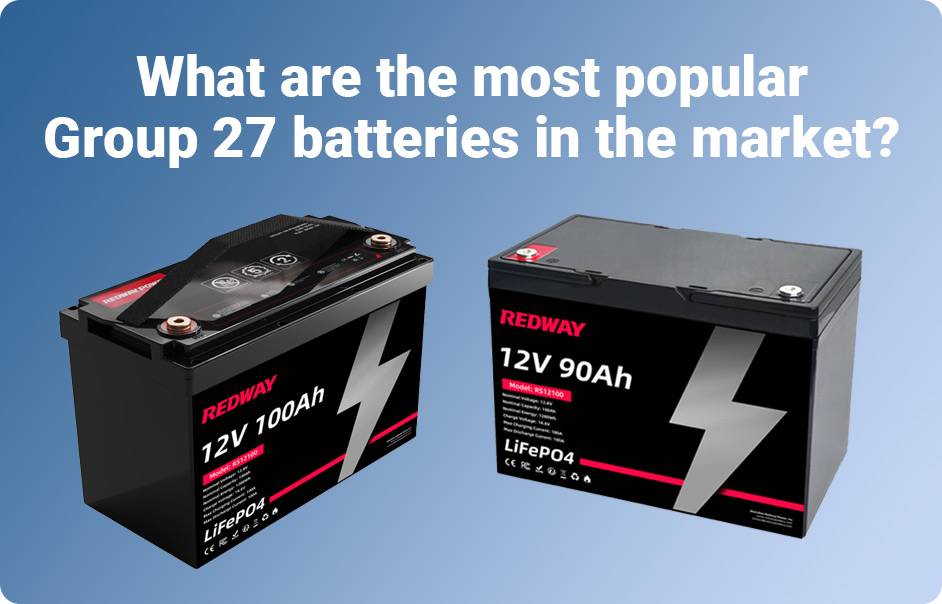
These batteries come with a range of capacities, reserve capacities, cold cranking amps, and weights, catering to various needs in different applications. While most of the batteries listed are AGM, SLA, or spill-proof batteries, offering versatile operation in different positions, they also span different chemistries including Enhanced Flooded, LiFePO4, and AGM/Gel hybrids. Interested consumers can check for the most up-to-date prices and offers on these batteries through the provided Amazon links for detailed information.
How to Choose a BCI Group 24, 27 or 31 Battery for Your Car
When selecting a BCI Group 24, 27, or 31 battery for your car, consider factors like size, CCA, and compatibility with popular car models. Group 27 batteries, for example, are versatile and commonly used in various applications, including trucks and industrial setups. Ensure the chosen battery meets your car’s requirements for optimal performance.
The BCI Battery groups 24, 27, and 31 stand among the most widely recognized battery groups, distinguished by their varying sizes which directly impact their capacity, CCA/MCA, and other ratings.
The physical dimensions of these groups are outlined in the following list:
– Group 24: 10.25 x 6.8125 x 8.875 inches (260 x 173 x 225 mm),
– Group 27: 12.0625 x 6.8125 x 8.875 inches (306 x 173 x 225 mm),
– Group 31: 13 x 6.8125 x 9.4375 inches (330 x 173 x 240 mm).
As the size and the volume of the batteries go up, so do their Amps, Ah, and other values.
How to Buy a Battery for Your Car
| Battery Type | Popular Cars it Fits |
| 65 (Top Terminal) | Ford, Lincoln, Mercury |
| 75/78 (Side Terminal) | GM, Chrysler, Dodge |
| 24/24F (Top Terminal) | Lexus, Honda, Toyota, Infiniti, Nissan, Acura |
| 34/78 (Dual Terminal) | GM, Chrysler, Dodge |
| 35 (Top Terminal) 86 (Top Terminal) 34 (Top Terminal) H Series (Top Terminal) | Nissan, Toyota, Honda, Subaru Dodge, Plymouth Chevy, Honda, Dodge Ford, BMW, Mercedes, Dodge, Chrysler |
BCI Group 27 batteries serve as versatile power sources across various applications. Primarily utilized in large UPS systems, medical and security setups, wheelchairs, automotive vehicles, trucks, and industrial environments, they excel in deep cycle or standby/float operations rather than as starting/cranking batteries. While photos are provided for general reference, minor cosmetic differences in the battery case may exist, though the outside dimensions and performance specifications align with the provided description.

